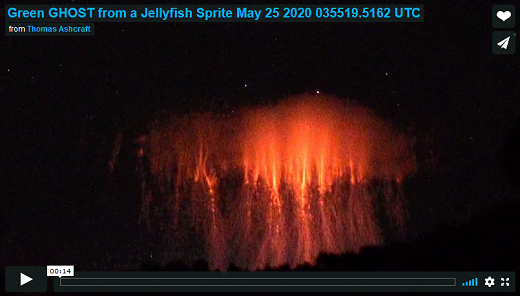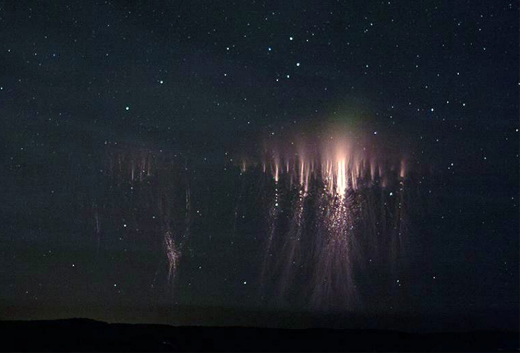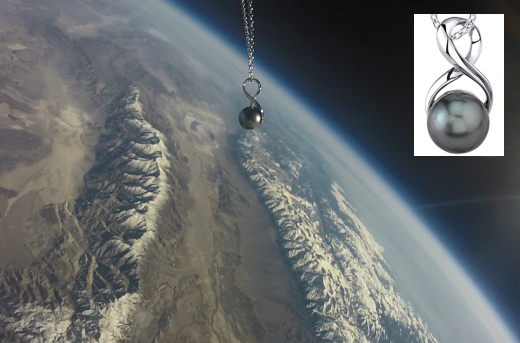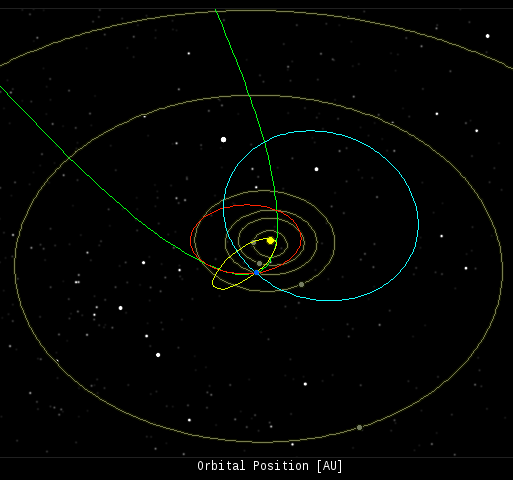Never miss another geomagnetic storm. Sign up for Space Weather Alerts and you'll receive a text message when auroras appear in your area. Aurora tour guides and professional astronomers use this service. Now you can, too! | | |
NEW SOLAR FLARE ACTIVITY: June has started with a bang. Earth-orbiting satellites detected a long-duration B-class solar flare on June 1st. The source is hiding behind the sun's southeastern limb. This event signals the approach of a new active region (possibly a sunspot) which will turn toward Earth later this week. Solar flare alerts: SMS Text.
INTRODUCING THE GREEN GHOST: Want to discover something new? Keep an eye on the tops of thunderstorms. Sprites, trolls, elves and pixies: These are just a handful of the exotic phenomena that have surprised researchers monitoring cloudtops since the 1980s. In fact, a new one has just been discovered. Introducing, the Green Ghost.
Thomas Ashcraft caught one over New Mexico on May 25th. Play his movie, and look for the green afterglow following the flash of this magnificent jellyfish sprite:

"In the past week I’ve captured two Green Ghosts over west Texas that were generated by strong peak current lightning strokes," says Ashcraft. "The one on May 25th registered 118 kAmperes on the National Lightning Detection Network and saturated VLF lightning sensors as far away as Great Britain and Germany."
"As far as I know there are no scientific journal articles regarding this new phenomenon and a handful of citizen scientists are leading the way," says Ashcraft.
Green Ghosts were discovered only 1 year ago by Hank Schyma, a Houston Texas-based storm chaser better known to his fans as Pecos Hank. "It was May 25, 2019," recalls Schyma. "I video-recorded some sprites over a storm in Oklahoma. Later, when I reviewed the footage, I noticed a mysterious green afterglow above some of the larger sprites."

Above: From the archives of Thomas Ashcraft, a Green Ghost photographed in 2014. “At the time I did not realize what I had captured,” he says.
Schyma worked closely with another storm chaser, Paul M. Smith. "We shared the footage with scientists and others on social media. Nobody had heard of it before. Many argued it might be a camera sensor artifact. Over the following weeks and months, Paul captured multiple other ghosts at high resolution, silencing the skepticism."
At the moment, no one knows for sure what causes Green Ghosts. Their color may be a clue. Green is commonly seen in auroras and airglow, two upper atmospheric phenomena that get their verdant hue from excited atoms of oxygen. The same could hold true for Green Ghosts. When the tops of strong sprites hit the airglow layer 96-97 km above Earth’s surface, oxygen atoms might briefly glow green.
Right or wrong, this hypothesis inspired the name Ghost. "It is an acronym for Green emissions from excited Oxygen in Sprite Tops," explains Schyma. "More importantly, we named them ghosts to maintain the theme of other transient luminous events such as sprites, trolls, elves and pixies."
In the USA, sprite season is just getting underway as summer approaches, bringing severe electrical storms. Stay tuned for more ghost stories.
Realtime Sprite Photo Gallery
Free: Spaceweather.com Newsletter
THE INFINITY BLACK PEARL: It came from Tahiti--and now it's been to the edge of space. On April 15, 2020, this genuine Black Tahitian South Sea Cultured Pearl flew to the stratosphere onboard an Earth to Sky Calculus cosmic ray balloon, soaring 107,611 feet above the Sierra Nevada mountains of central California:

You can have it for $249.95. The students of Earth to Sky Calculus are selling these exotic space pearls to fund their cosmic ray monitoring program.
Measuring 9 mm in diameter, the pearl is mounted on a 925 sterling silver infinity twist and suspended on a matching 17 inch long sterling silver chain. Each pearl comes with a greeting card showing the pendant in flight and telling the story of its journey to the edge of space.
Far Out Gifts: Earth to Sky Store
All sales support hands-on STEM education
Realtime Space Weather Photo Gallery
Free: Spaceweather.com Newsletter
Realtime Aurora Photo Gallery
Free: Spaceweather.com Newsletter
Every night, a network of
NASA all-sky cameras scans the skies above the United States for meteoritic fireballs. Automated software maintained by NASA's Meteoroid Environment Office calculates their orbits, velocity, penetration depth in Earth's atmosphere and many other characteristics. Daily results are presented here on Spaceweather.com.
On June 1, 2020, the network reported 4 fireballs.
(4 sporadics)

In this diagram of the inner solar system, all of the fireball orbits intersect at a single point--Earth. The orbits are color-coded by velocity, from slow (red) to fast (blue). [Larger image] [movies]
Potentially Hazardous Asteroids (
PHAs) are space rocks larger than approximately 100m that can come closer to Earth than 0.05 AU. None of the known PHAs is on a collision course with our planet, although astronomers are finding
new ones all the time.
On June 1, 2020 there were 2037 potentially hazardous asteroids.
 |
Recent & Upcoming Earth-asteroid encounters: | Asteroid | Date(UT) | Miss Distance | Velocity (km/s) | Diameter (m) |
| 2020 JP2 | 2020-May-27 | 11.6 LD | 8.6 | 18 |
| 2020 KJ3 | 2020-May-27 | 7.8 LD | 10.1 | 23 |
| 2020 JN3 | 2020-May-27 | 4.3 LD | 5.8 | 12 |
| 2020 KV | 2020-May-28 | 7.2 LD | 12.7 | 37 |
| 2020 KM4 | 2020-May-28 | 2.4 LD | 5.5 | 9 |
| 2020 KW4 | 2020-May-28 | 4.2 LD | 12 | 19 |
| 2020 KF5 | 2020-May-28 | 0.6 LD | 10.9 | 5 |
| 2020 KJ4 | 2020-May-28 | 0.4 LD | 4.9 | 4 |
| 2020 JM1 | 2020-May-28 | 9.5 LD | 5.8 | 22 |
| 2020 JV2 | 2020-May-29 | 9.2 LD | 11.5 | 26 |
| 2020 KB | 2020-May-29 | 7.5 LD | 12.2 | 38 |
| 2020 KD3 | 2020-May-29 | 7.9 LD | 7.4 | 19 |
| 2020 KF6 | 2020-May-29 | 17.9 LD | 12.4 | 64 |
| 2020 KU1 | 2020-May-29 | 15.4 LD | 12.4 | 44 |
| 2020 KV1 | 2020-May-29 | 10.1 LD | 4.8 | 20 |
| 2020 KC5 | 2020-May-29 | 1 LD | 9.1 | 12 |
| 2020 KO4 | 2020-May-29 | 1.6 LD | 10.9 | 14 |
| 2020 KB7 | 2020-May-31 | 4.4 LD | 4 | 10 |
| 2020 KW5 | 2020-May-31 | 6.2 LD | 19.3 | 20 |
| 2020 KZ4 | 2020-May-31 | 8.5 LD | 6.5 | 18 |
| 2020 KT6 | 2020-Jun-01 | 8.7 LD | 10.2 | 14 |
| 2020 KN2 | 2020-Jun-02 | 5.8 LD | 8.4 | 18 |
| 2020 KK7 | 2020-Jun-02 | 1.3 LD | 15.2 | 20 |
| 2020 KD4 | 2020-Jun-02 | 10.5 LD | 5.2 | 21 |
| 2020 KF | 2020-Jun-02 | 12.1 LD | 10.8 | 26 |
| 2020 KJ1 | 2020-Jun-02 | 5.5 LD | 5.1 | 19 |
| 2020 KE4 | 2020-Jun-03 | 7.7 LD | 9.1 | 31 |
| 2020 KN5 | 2020-Jun-04 | 16.2 LD | 12.7 | 32 |
| 2020 KA6 | 2020-Jun-05 | 11.7 LD | 11.6 | 17 |
| 163348 | 2020-Jun-06 | 13.3 LD | 11.1 | 339 |
| 2020 KO1 | 2020-Jun-06 | 15.5 LD | 7.3 | 35 |
| 2020 KQ1 | 2020-Jun-06 | 13.4 LD | 14.9 | 49 |
| 2020 KA7 | 2020-Jun-07 | 10.4 LD | 7.3 | 31 |
| 2020 KK3 | 2020-Jun-07 | 17.8 LD | 11.9 | 29 |
| 2013 XA22 | 2020-Jun-08 | 7.6 LD | 6.7 | 98 |
| 2020 KZ3 | 2020-Jun-08 | 3.2 LD | 6 | 21 |
| 2020 KY | 2020-Jun-10 | 17.3 LD | 2.4 | 21 |
| 2020 JQ2 | 2020-Jun-11 | 15.2 LD | 4.5 | 24 |
| 2020 JS1 | 2020-Jun-11 | 9.9 LD | 5 | 19 |
| 2020 JU1 | 2020-Jun-13 | 19 LD | 6.6 | 48 |
| 2020 KB3 | 2020-Jun-13 | 3.2 LD | 7.5 | 46 |
| 2017 MF7 | 2020-Jun-14 | 3.7 LD | 10.9 | 23 |
| 2020 KP6 | 2020-Jun-16 | 3.6 LD | 10.8 | 38 |
| 2020 JU3 | 2020-Jun-17 | 6.9 LD | 10.9 | 55 |
| 2020 KF3 | 2020-Jun-17 | 12.5 LD | 3.5 | 14 |
| 2018 PD22 | 2020-Jun-19 | 17.2 LD | 14.6 | 56 |
| 2020 KR1 | 2020-Jun-22 | 11.6 LD | 6.8 | 42 |
| 441987 | 2020-Jun-24 | 9.8 LD | 12.9 | 186 |
| 2017 FW128 | 2020-Jun-25 | 6.9 LD | 5.4 | 11 |
| 2020 JX1 | 2020-Jun-29 | 3.3 LD | 5 | 59 |
| 2019 AC3 | 2020-Jul-01 | 10.5 LD | 3.4 | 12 |
| 2007 UN12 | 2020-Jul-04 | 16.7 LD | 2.9 | 6 |
| 2020 KJ7 | 2020-Jul-13 | 11.9 LD | 3.4 | 30 |
| 2009 OS5 | 2020-Jul-13 | 17.6 LD | 2.6 | 45 |
| 2016 DY30 | 2020-Jul-19 | 9 LD | 15.1 | 3 |
| 2002 BF25 | 2020-Jul-21 | 9.4 LD | 6.8 | 129 |
Notes: LD means "Lunar Distance." 1 LD = 384,401 km, the distance between Earth and the Moon. 1 LD also equals 0.00256 AU. MAG is the visual magnitude of the asteroid on the date of closest approach. | | Cosmic Rays in the Atmosphere |
SOMETHING NEW! We have developed a new predictive model of aviation radiation. It's called E-RAD--short for Empirical RADiation model. We are constantly flying radiation sensors onboard airplanes over the US and and around the world, so far collecting more than 22,000 gps-tagged radiation measurements. Using this unique dataset, we can predict the dosage on any flight over the USA with an error no worse than 15%.
E-RAD lets us do something new: Every day we monitor approximately 1400 flights criss-crossing the 10 busiest routes in the continental USA. Typically, this includes more than 80,000 passengers per day. E-RAD calculates the radiation exposure for every single flight.
The Hot Flights Table is a daily summary of these calculations. It shows the 5 charter flights with the highest dose rates; the 5 commercial flights with the highest dose rates; 5 commercial flights with near-average dose rates; and the 5 commercial flights with the lowest dose rates. Passengers typically experience dose rates that are 20 to 70 times higher than natural radiation at sea level.
To measure radiation on airplanes, we use the same sensors we fly to the stratosphere onboard Earth to Sky Calculus cosmic ray balloons: neutron bubble chambers and X-ray/gamma-ray Geiger tubes sensitive to energies between 10 keV and 20 MeV. These energies span the range of medical X-ray machines and airport security scanners.
Column definitions: (1) The flight number; (2) The maximum dose rate during the flight, expressed in units of natural radiation at sea level; (3) The maximum altitude of the plane in feet above sea level; (4) Departure city; (5) Arrival city; (6) Duration of the flight.
SPACE WEATHER BALLOON DATA: Approximately once a week, Spaceweather.com and the students of Earth to Sky Calculus fly space weather balloons to the stratosphere over California. These balloons are equipped with radiation sensors that detect cosmic rays, a surprisingly "down to Earth" form of space weather. Cosmic rays can seed clouds, trigger lightning, and penetrate commercial airplanes. Furthermore, there are studies ( #1, #2, #3, #4) linking cosmic rays with cardiac arrhythmias and sudden cardiac death in the general population. Our latest measurements show that cosmic rays are intensifying, with an increase of more than 18% since 2015:

The data points in the graph above correspond to the peak of the Regener-Pfotzer maximum, which lies about 67,000 feet above central California. When cosmic rays crash into Earth's atmosphere, they produce a spray of secondary particles that is most intense at the entrance to the stratosphere. Physicists Eric Reneger and Georg Pfotzer discovered the maximum using balloons in the 1930s and it is what we are measuring today.
En route to the stratosphere, our sensors also pass through aviation altitudes:

In this plot, dose rates are expessed as multiples of sea level. For instance, we see that boarding a plane that flies at 25,000 feet exposes passengers to dose rates ~10x higher than sea level. At 40,000 feet, the multiplier is closer to 50x.
The radiation sensors onboard our helium balloons detect X-rays and gamma-rays in the energy range 10 keV to 20 MeV. These energies span the range of medical X-ray machines and airport security scanners.
Why are cosmic rays intensifying? The main reason is the sun. Solar storm clouds such as coronal mass ejections (CMEs) sweep aside cosmic rays when they pass by Earth. During Solar Maximum, CMEs are abundant and cosmic rays are held at bay. Now, however, the solar cycle is swinging toward Solar Minimum, allowing cosmic rays to return. Another reason could be the weakening of Earth's magnetic field, which helps protect us from deep-space radiation.
| | The official U.S. government space weather bureau |
| | The first place to look for information about sundogs, pillars, rainbows and related phenomena. |
| | Researchers call it a "Hubble for the sun." SDO is the most advanced solar observatory ever. |
| | 3D views of the sun from NASA's Solar and Terrestrial Relations Observatory |
| | Realtime and archival images of the Sun from SOHO. |
| | from the NOAA Space Environment Center |
| | fun to read, but should be taken with a grain of salt! Forecasts looking ahead more than a few days are often wrong. |
| | from the NOAA Space Environment Center |
| | the underlying science of space weather |
 | To find reviews of new online casino sites in the UK try The Casino DB where there are hundreds of online casino reviews complete with bonuses and ratings. Get a bonus when playing at a new casino in the UK. The Genie got you covered! Looking for a new online casino? Try Casimpo the new site dedicated to making online casino simple and easy for all. |
| | These links help Spaceweather.com stay online. Thank you to our supporters! |
| | | | | | |

